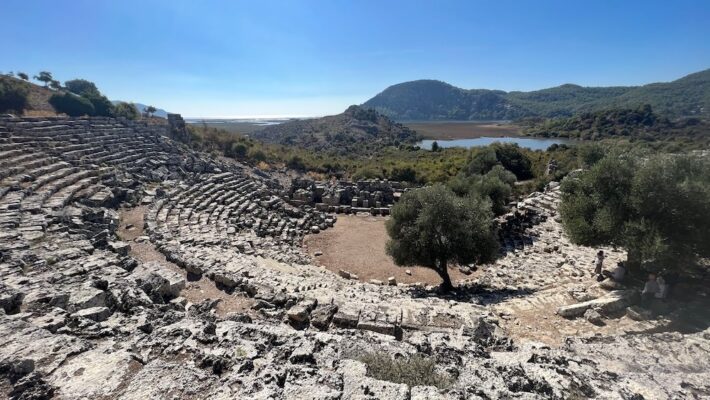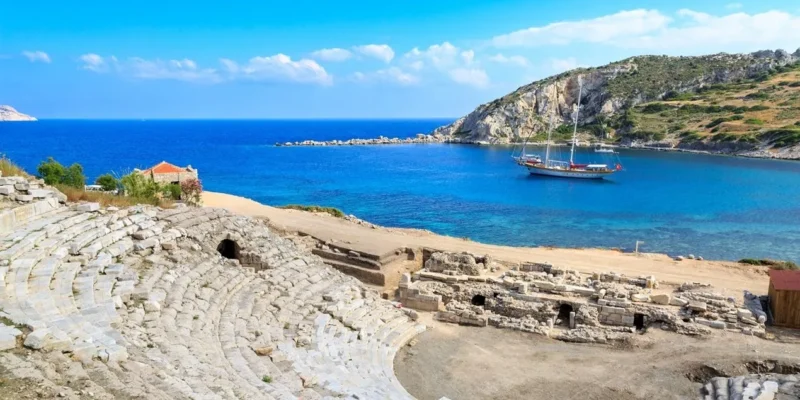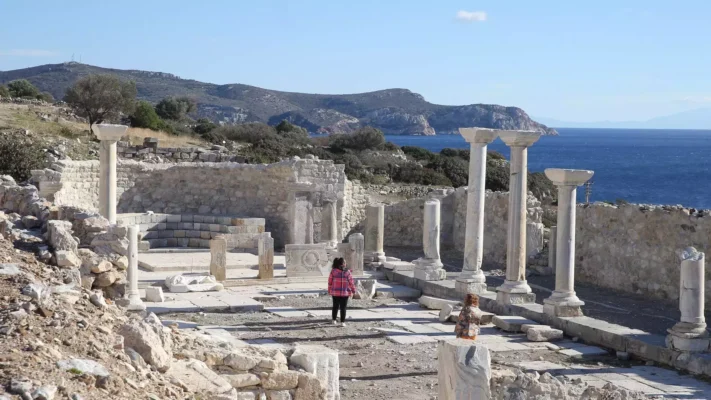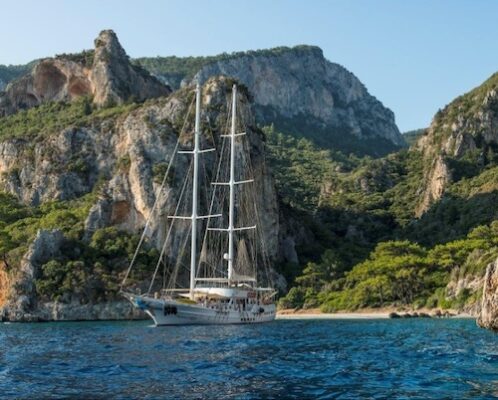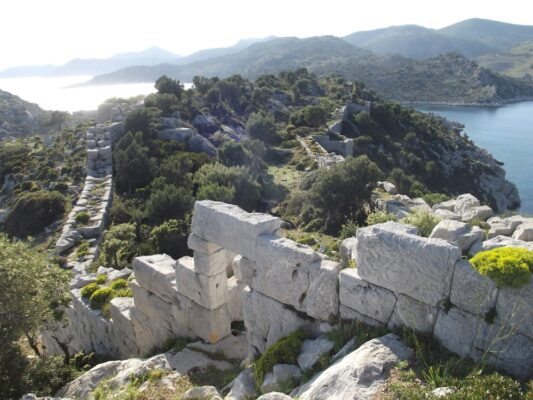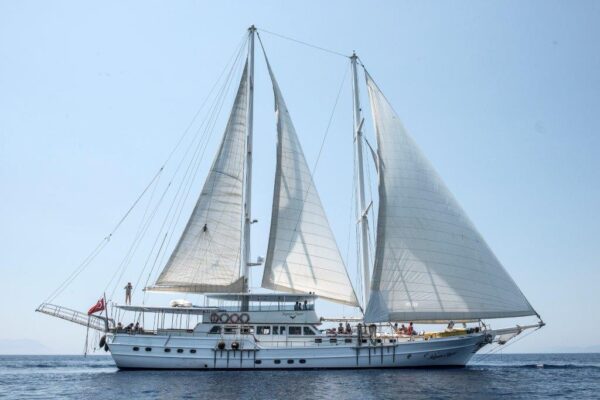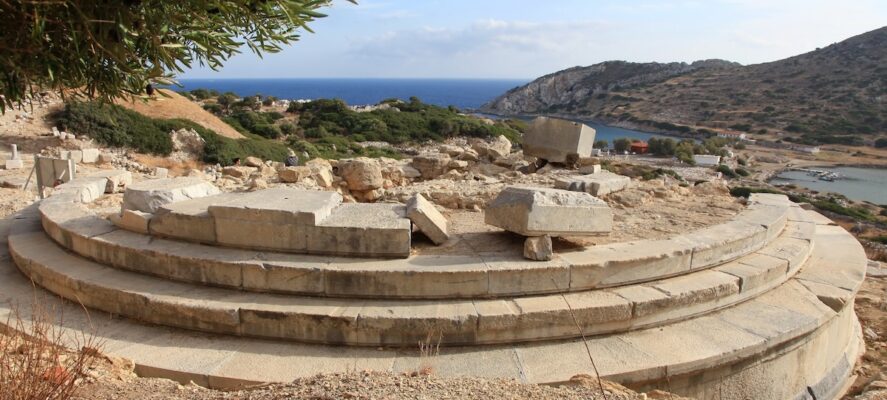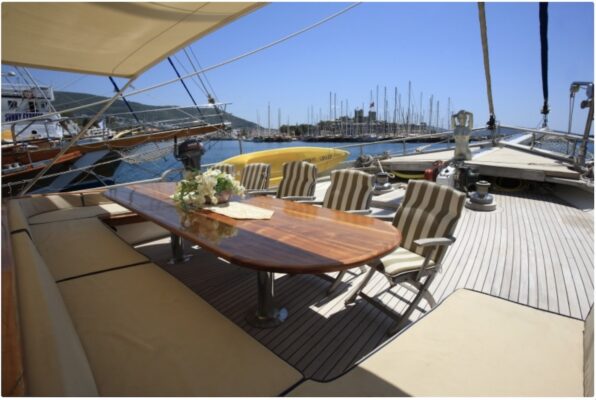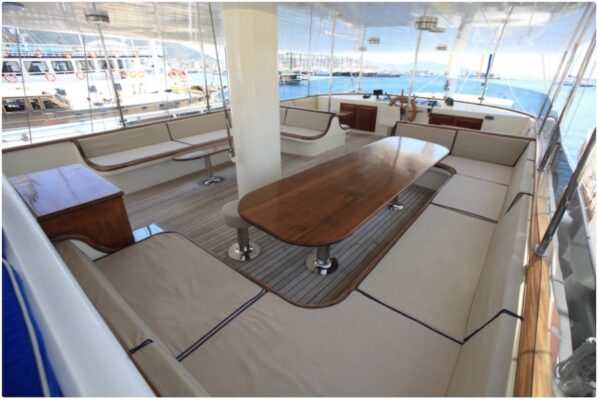Coastal Caria
Archeology Cruise on the Turkish Coast (Bodrum to Fethiye)
Cultural Program (maritime travel)
Ancient Greek archeology, Byzantine architecture, coastal towns, secluded bays, ancient Greek ampitheaters, castles of the Knights Hospitaller of the Order of St. John, swimming and snorkeling, gourmet eating and wine under the stars.
Sept. 25th - Oct 4th, 2026
Combine with: Coastal Lycia (Oct 3rd - 12th, 2026)
Registration: SPACES AVAILABLE (Max 17 participants)
Join us for an extraordinary adventure along the ancient maritime trading routes where the Mediterranean meets the Aegean Sea. Our tour "Coastal Caria: Archeology Cruise" is a feast for the senses as we sail the high seas, anchoring in sheltered harbors to explore ancient Carian cities. We begin the tour in Bodrum (ancient Halikarnassus) with an exploration of the Mausoleum (one of the Seven Wonders of the Ancient World), and the museum of underwater archeology housed in a 15th century castle built by Crusader Knights (the Order of St. John). On Day 3, we embark on a private gulet charter - a traditional wooden sailing ship - for our real adventure: a cruise along the famous “Turquoise coast” of the Carian coast! Our guests absolutely love the natural beauty of this stunning coastline, with its steep arid hillsides plunging into clear blue water. The route takes us past several ancient Carian cities and fortifications that were later Hellenized and Romanized in classical antiquity. Among these, the highlights are surely the cities of Halikarnassos, the double-harbor city of Knidos, the walls of Loryma, Kaunos city theater, the ruins of Lydae, Telmessos, and Tlos. Some of these sites have never been excavated by archeologists and many remain accessible only from the sea.
Onboard, we will be in the capable hands of a professional captain and crew of 5. A private chef serves delicious freshly cooked meals three times per day, and we will have ample time to sip wine and look at the stars from the deck of our gulet.
Many of our guests who have enjoyed our other tours will be thrilled at this opportunity. For new visitors to our company, please see our review page for a sense of what to expect. Read more about the program below!
Details:
- Arrive: Bodrum International Airport (BJV).
- Depart: Dalaman International Airport (DLM), transfer to Fethiye.
- 10 day trip (2 nights Bodrum, 7 nights on private charter boat).
- Optional 2-night post-tour stay in Fethiye with a bus tour to the ancient city of Tlos
- Visas: US passport holders need to obtain a Turkish evisa.
- Maximum 17 guests (only a deposit secures a place on tour).
Tour Leaders:
- John Graham
- Invited specialists
Accommodation:
- Best available boutique hotels, gulet charter.
Brochure:
- Contact us for the invitational tour brochure and registration form. Email: admin@johngrahamtours.com
Registration:
- Submit registration form (sent at your request)
- Send deposit of $1500 to secure your place (details in registration form)
Castles of Caria tour route:
Fees:
- Coastal Caria tour fees are detailed in the tour brochure. Please email us for a copy!
- Inquire about discounts for the Coastal Caria tour if you have been on a previous tour with JohnGrahamTours!
Payment Methods:
- Bank transfer (preferred)
- Credit card via Paypal (3% Paypal charge applies)
Pre/Post-Tour Options
- 2-day (2-night) post-tour extension in Fethiye. October 4th-6th, 2026. See brochure for details.
- Join our sister program, Coastal Lycia: Archeology Cruise (Oct 4th-12th), immediately following this tour.
Included:
- Accommodation in high quality boutique hotels in Bodrum and Fethiye; gulet cabins as described in the itinerary.
- All ground transportation including airport transfers.
- All meals, table wine included.
- All museum and site entrances.
Not Included:
- International airfare
- Tips for primary guide and gulet crew (see details in brochure).
- Personal services (laundry, etc.).
- Personal bar tab on the gulet (beer, cocktails, etc.).
- Travel insurance (required).
Mobility-Fitness:
- Standard: 4/10 on the mobility scale (10 being the most demanding).
- General fitness required. The boat has narrow passageways with steep staircases. While the shore excursions are optional, those that come should be prepared for trails on rocky terrain.
- Guests must be able to enter/exit the dinghy from the staircase.
- While the boat is cruising, balance is required when moving around the boat.
Special Notes:
- Architectural focus, historical focus
- Wine and cuisine
- Exceptional natural landscapes, as seen from the sea
- Swimming, kayaking, and water sports.
Weather:
- We will expect late summer weather on the Mediterranean in September-October with temperatures up to 80s F, going down into the 60s at night. While it usually does not rain in this season, we will expect a few cloudy days, which will be perfect for shore explorations. In the afternoons, the wind could pick up, so a long sleeve shirt or windbreaker might be desirable. The cabins have air conditioning units, but these are unlikely to be necessary.
Packing:
- There is limited space on the boat, so please pack light. One medium suitcase maximum.
- Comfortable walking shoes for shore excursions through towns and around archeology sites.
- Folding walking sticks for rocky trails through archeological sites.
- Sunhats, sunscreen, sun-glasses, swimsuits, swimming goggles, etc.
Overview
We are excited to welcome our guests to our new archeology and cruising program, "Coastal Caria" and "Coastal Lycia." These two tours will run consecutively, as we sail east from Bodrum to Fethiye on the "Coastal Caria" program, and then continue further east to Myra on the "Coastal Lycia" program. We anticipate that some guests will join us for both tours!
This has been a maritime highway for millennia, with the shipwrecks, ancient cities, and ambiance to prove it!
It is impossible to see everything in one trip, yet this trip packs in a number of the significant sites while maintaining a decidedly leisurely pace. Daily cruises transport us across turquoise waters to ancient cities, modern towns, and sheltered bays with pristine swimming and snorkeling possibilities. We include some longer optional walks. With a fantastic chef and plenty of gourmet Turkish red wine on board, every evening will be a special night out under the stars.
September-October is the perfect time to cruise these coasts, as the water temperature is still warm enough to enjoy a swim at any time of the day or night, but the extreme temperatures of the summer have worn off. Likewise, sailing is relatively calm because the dramatic northerly winds of the Aegean Sea don't arrive until December.
Our captain has 40 years experience sailing these waters, and personally built this gulet (his fifth). He and his crew of 4 keep the boat spotlessly clean, while also attending to our guest's every need. Join us, as we enter the world of ancient Mediterranean maritime travelers!
Travel Program
We begin our tour in the ancient city of Halikarnassos (modern Bodrum), an important cultural center and birthplace of important historical figures like Herodotus, the “father of history.” The port has proved vital throughout maritime history, with remnants of past empires dotting its protected bay; the tomb of Mausolus (built around 350 BC) was considered one of the seven wonders of the world. Alexander the Great assaulted the castle, such was its importance in his era. On our first day, we will explore the 15th century Castle of St. Peter built by the Knights Hospitaller in the 15th century, a huge fortress above the Bodrum bay that now houses the Museum of Underwater Archeology within its many towers. This unique museum features a dizzying array of incredible artifacts excavated from ancient shipwrecks along the Carian coast.
After embarking on our gulet on Day 3, we meet the crew, sail to a secluded harbor and enjoy our first dinner aboard. On several evenings, we have lecture-discussions before dinner about topics of interest, like the Aphrodite of Knidos.
On Day 4, we explore the double-harbored city of Knidos at the furthest western tip of the Datcha peninsula, one of the archeological highlights of the tour. This city with shrines to Aphrodite and Apollo was the center of the confederation of states called the Dorian Hexapolis in the 4th century BC. With its sandy isthmus between rocky shore and island, it was famous for two protected bays at opposite points of the wind. Thus, ancient seafarers awaiting favorable winds would often stay for many days worshipping at the city’s major shrine dedicated to Aphrodite, and reputedly visiting the city’s equally famous porneio. Today, the hillside is littered with the remains of hundreds of buildings and marble shrines, making it easy to imagine an incredible city with sea views in every direction. A theater and agora dominate the lower structures along the shore, while the shrine sites are situated further up the slope.
On subsequent days, we explore a number of ancient sites including the impressive Hellenistic fortifications of Loryma that look directly across the straits to the island of Rhodes. In 305 BC, the Athenian general Demetrius "the Besieger" assembled a fleet of some 90 ships in this bay for an invasion of Rhodes. But that shouldn’t be considered ancient: archeological surveys have discovered that this bay has been inhabited since at least 5000 BC.
Our visit to the sprawling ruin of the ancient port city of Kaunos will be one of the archeological highlights of the trip. Our approach is by flat-bottomed river boat through a silted-up delta which used to be the port. As we approach, we see an impressive array of rock-cut tombs carved into the cliff side, a mixture of monumental Persian tomb carving and Ionian Greek columnar architectural features. In the city itself, we find all the elements of a prosperous city in antiquity: the theater, the agora, shrines to the Gods, tombs for the elites. There is also an infrequently visited but well-preserved Byzantine church from the late 6th century AD, which offers the chance to discuss the ways in which Christianization affected cities throughout the Eastern Roman Empire. We often encounter layers and layers of history in each site with the earliest remains reflecting the local Carian people, followed by Greek and Roman monumental structures, and finally Byzantine churches.
On our way to Fethiye, we anchor near a ruin dubbed "Cleopatra's bath" because of some partially submerged ruins of a bathhouse. An ancient footpath winds up from the spot into the hills above where the ancient city of Lydae once graced a valley among hills resembling a circular crown. This ancient Lycian city, as yet unexcavated due to its inaccessible position (there is no car road to the location), commands an impressive vantage point over the seas in three directions. For those intrepid enough to climb 2 hours uphill, we are rewarded with the suggestion of a large and complex city ruin including the remains of a Greek theater, a Roman agora, and monumental Roman tombs from the local family who appear to have been important members of Roman society. Inscriptions on several tombs give us their name: Caius Julius Heliodorus, to give one example. Discovered in the 1880s by Theodore and Mabel Bent, not much has changed since their first descriptions of the place as “a paradise for archeologists and tortoises.”
The tour ends after breakfast on Sunday, when we disembark in the port of Telmessos (modern Fethiye).
For those who are not ready to head directly to the airport, we offer a two day post-tour extension to explore the valuable sights in this important border region between ancient Caria and Lycia. Telmessos once boasted an important harbor, and one can still find the remains of an semi-circular theater and several Lycian-type sarcophagi scattered around the city. In the cliffs above the city are the iconic rock-cut tombs of Amyntas, one of the most photographed tombs on the coast. Nowadays the town is charming yachting port and tourist starting point for walkers on the Lycian Way 500km trek, para-gliding, and other sports. It is good for a day’s walk around, with the still-functioning 16th century Ottoman bath house a popular site. In addition to a walking tour of this town, the extension package will feature a full day bus excursion to inland cities such as Tlos and Pinara. See the brochure for more details.
Historical-Cultural view
The “Coastal Caria” tour is so named because this region of southwestern Anatolia was once inhabited by the Carian people, attested in many ancient Greek sources. We explore various layers of history, including its bronze-era ancient seafaring past (2000-1200 BC), Mycenean migrations starting in 1100 BC, its Classical era under Persian rule (550-330 BC), then later Hellenistic, Roman, and Christian eras. This coastline was not a focus of Seljuk or Ottoman industry, but the two centuries of Knights Hospitaller did leave an architectural legacy as we will see at the Petronium Fortress in Bodrum.
The jutting peninsulas that stretch into the Aegean Sea are precipitously mountainous, making travel by land nearly impossible even today and rendering many areas accessible only be sea. But this terrain also provided plentiful safe harbors for seafarers traveling from Egypt and Canaan to the Greek city states and beyond. The evidence for this vibrant trade route is discovered in one of the best underwater archeology museums in the world, housed in the historic fortress in Bodrum and one of our key destinations in the first days of our tour. Within this museum, we learn about the trade goods of sea merchants from as early as 1300 BC whose ships were wrecked off the Carian coast but have been recovered piece by piece using advanced diving techniques in the modern era.
The Carian people were a mainland tribe who had their own language and alphabet, but established trade and political ties with various Greek entities. For example, king Mausolus of Halikarnassos was a satrap of the Persian Achaemenid empire but hired Greek architects from Priene to build his magnificent burial chamber. The resulting structure gave the name “mausoleum” to all future extravagant tombs because of its immense structure and incredibly ornate carvings. The language is attested in a variety of inscriptions that have baffled scholars for centuries, but was finally deciphered in the 1980s with the help of bi-lingual inscriptions found in Egypt, where Carian mercenaries worked in the 6th century BC.
The charter boat
The boat is a double-masted ketch style gulet, measuring 135 feet long, skippered and owned by a captain who has over 40 years’ experience sailing these coastlines (his grown children are also skippers in their own right!). I think it’s important that he skippers his own boat, so he knows every detail about its engine and water systems. The captain also knows all the most favorable anchorages, whether we are at port or in a secluded bay. The boat features 11 cabins for potentially 22 guests (in addition to 5 crew) and features a variety of common spaces both shady and sunny, forward and aft, indoor and outdoor, and a very nice bar space. There are even some sunning cushions on the upper solar-panel deck which were placed specially, according to the captain, for French clients who insisted on nude sun-bathing. The point is this boat has a lot of common space to find a conversation corner or a quiet corner. My plan is to limit our group to 17 people rather than fill the boat to capacity, thus giving us the luxury of even-more deck space.
The beds have good quality mattresses, and each cabin features a private bath/shower. The boat is older than others we saw (built in 2000) with less shiny trim, but the boat features solid teak cabin doors, a strong hull, classic portal windows, and the captain spends his life either sailing or upgrading the boat. For example, while inspecting the boat in dry dock last week, he was in the process of repainting the hull and replacing every air-conditioning motor on the boat (each room has an individual air conditioner, which are especially needed for cruises in July and August). I found that the sleek new gulets are extremely over-priced for what one gets, which is essentially the same-sized cabins and the same amount of deck space. The newer boats feature jacuzzis on the deck, private television sets in each room, shiny metal/glass trim etc but for my eye, don’t justify double or triple the rental expense.
In summary, I’ve chosen the older, well-maintained boat at a reasonable cost, skippered by the owner himself, with extra deck space which I’ll further maximize by limiting our total group size.
Request the full brochure! Email: admin@johngrahamtours.com
Tour Locations:
Bodrum
+ In Bodrum, where we end our tour, we visit the Halikarnassos mausoleum ruins, one of the seven wonders of the ancient world. We also visit the impressive 15th castle of the Knights Hospitaller, which houses the world famous museum of Underwater Archeology. Each tower in the castle is a museum exhibit featuring one or more ancient shipwrecks that have been meticulously excavated from the nearby seabed. The finds are absolutely extraordinary!
Carian coast of Turkiye
+ We will visit the well-preserved double-harbor ancient Greek city of Knidos, the bustling trading town of Datcha, the remnants of the Ancient Greek city of Loryma above the Bozukkale bay, the significant port city of Kaunos, and the unexcavated hilltop town of Lydae. Throughout the voyage, we enjoy exploring the intricate coastline of secluded bays and inlets of this fascinating coastline.
Fethiye - Tlos
+ The post-tour extension includes an exploration of the port town of Fethiye, which in ancient times was called Telmessos. A theater, tombs, and other ruins can still be viewed near the old port. We spend a day taking a bus trip into the mountains to visit the important hilltop city of Tlos. High quality hotel reservations.
Request the full brochure! Email: admin@johngrahamtours.com
